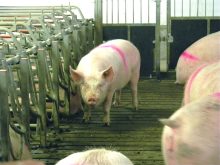Slow export growth, a larger than expected U.S. pig run and an expanding breeding herd are sparking pessimism for 2023 American hog prices.
Steve Meyer, an economist with Iowa’s Kearns and Associates, said few predicted the early 2023 large run of hogs and a recent United States Department of Agriculture Hogs and Pigs report was off the mark.
Why it matters: The Canadian hog price is strongly tied to the American price, with pigs and finished pork flowing back and forth across the border.
Read Also

Footflats Farm recognized with Ontario Sheep Farmers’ DLF Pasture Award
Gayla Bonham-Carter and Scott Bade, of Footflats Farm, win the Ontario Sheep Farmers’ 2025 DLF Ontario Pasture Award for their pasture management and strategies to maximize production per acre.
“Quarterly hogs and pig report from February, very much as expected, and as it’s turned out, very much wrong,” Meyer told attendees of Ontario Pork’s annual meeting last month. “Sometimes it happens, and it hasn’t happened for a while.”
He said the USDA reports from June and September 2022 were spot on, and there was no reason to doubt it until February. In December, Meyer said the breeding herd was up a half per cent from the year before, the first growth since 2012.
“The last couple of weeks, we’ve run 80,000 to 100,000 head above the slaughter forecast, and weights have gone up. That is not a good omen,” said Meyer. “That says we’re backing up a few pigs, maybe, so I’m really concerned about that. We’ll see if we get current.”
Meyer said weights are not rising as they have been for years. They were ahead of the five-year average in the first half of the year and behind in the second half.
Despite a profitable 2021 and 2022, Meyer said there was no breeding herd expansion, and with 2023 off to a rough start, he suggested there might be a contraction.
The slaughter forecast is up one per cent, close to last year, with most of it in the fourth quarter, predicated on a return to one to 1.5 per cent growth in litter sizes.
Canada-U.S. relations have been strained over the years, in part because Canada added almost one per cent to U.S. domestic supply.
Meyer said there was no griping about the influx because the industry understood the difficulties that arose when China delisted Canadian processing facilities.
The U.S. industry is waiting for a Supreme Court decision regarding California’s Proposition 12, Farm Animal Confinement, which requires producers to provide pregnant pigs with 24 square feet of space and the ability to stand and turn around in their pens. It also bans state sales of pork not raised within the proposed housing specifications. Prop 12 also applies to veal calves and egg-laying hens.
“If (the court finds) it is a violation of what we call the Dormant Commerce Clause of the Constitution, it will be declared unconstitutional and be sent back to a district court in California for a trial,” said Meyer.
“If they say yes, it’s OK with the Dormant Commerce Clause, then California Department Food and Ag can move with enforcing the rules, and they’re going to enforce the rules on you and us.”
If the matter goes to trial, it will drag on further, but if the California proposition is approved, enforcement wouldn’t begin until at least July, he said.

Exports slower
Chinese tariffs on American pork could open opportunities for Canada.
Stuck with an uncompetitive 40 per cent Chinese tariff and Value Added Tax on U.S. products, Meyer said Canada and other countries stand to benefit more.
Exports challenged the United States pork industry with a drag on 2022 wholesale and hog demands, except from Mexico, Korea and the Dominican Republic.
U.S. pork export forecasts indicate a 2023 increase of three to five per cent, depending on the source.
However, the USDA pegged it at one per cent.
Mexico will remain a robust export destination for U.S. pork, and Meyer said he isn’t overly concerned that Mexico’s recent agreement with Brazil will severely impact U.S. products.
He also suggested significant European Union output reductions and higher prices, especially in Japan and Korea, could be an opportunity for the U.S., particularly in Asian markets.
“We have free trade agreements with 10 South American countries that get fully implemented over the next four or five years,” said Meyer. “Some of them already are. Zero tariffs, zero quotas, and I think those are our growth markets for the short term.
“Price forecast — decidedly ugly. I mean, this is not very pretty,” he said. “So, the question here is, will demand recover?”
U.S. domestic demand is strong but slipping from record-level highs, he said.















